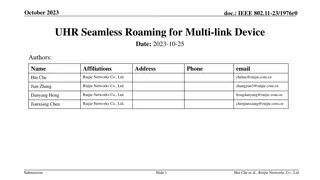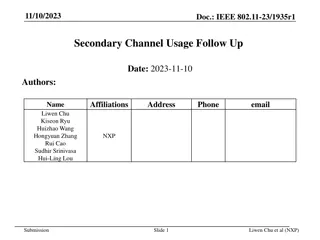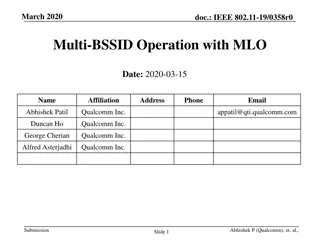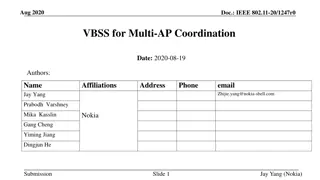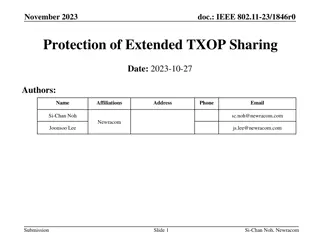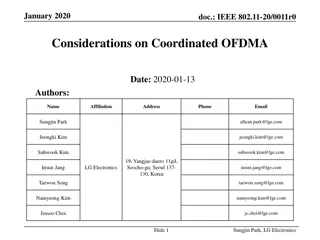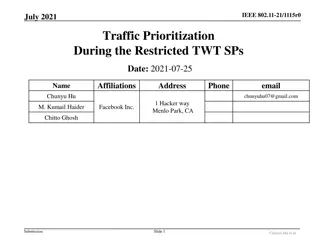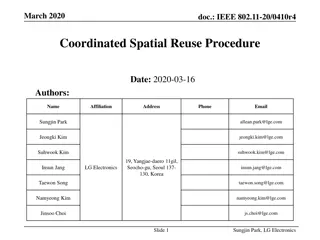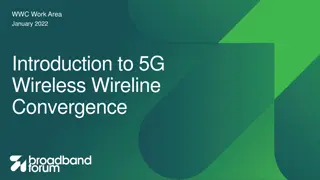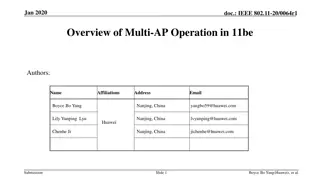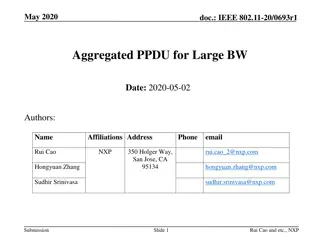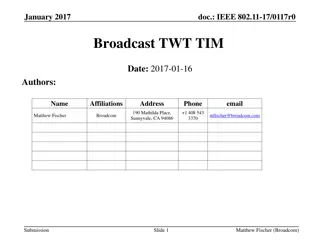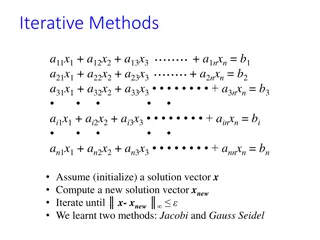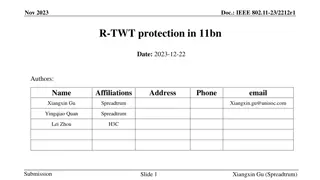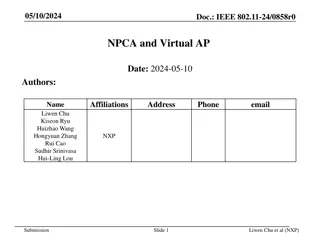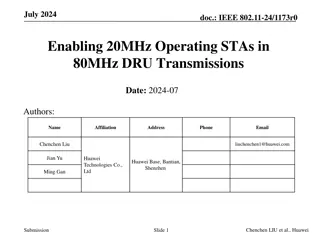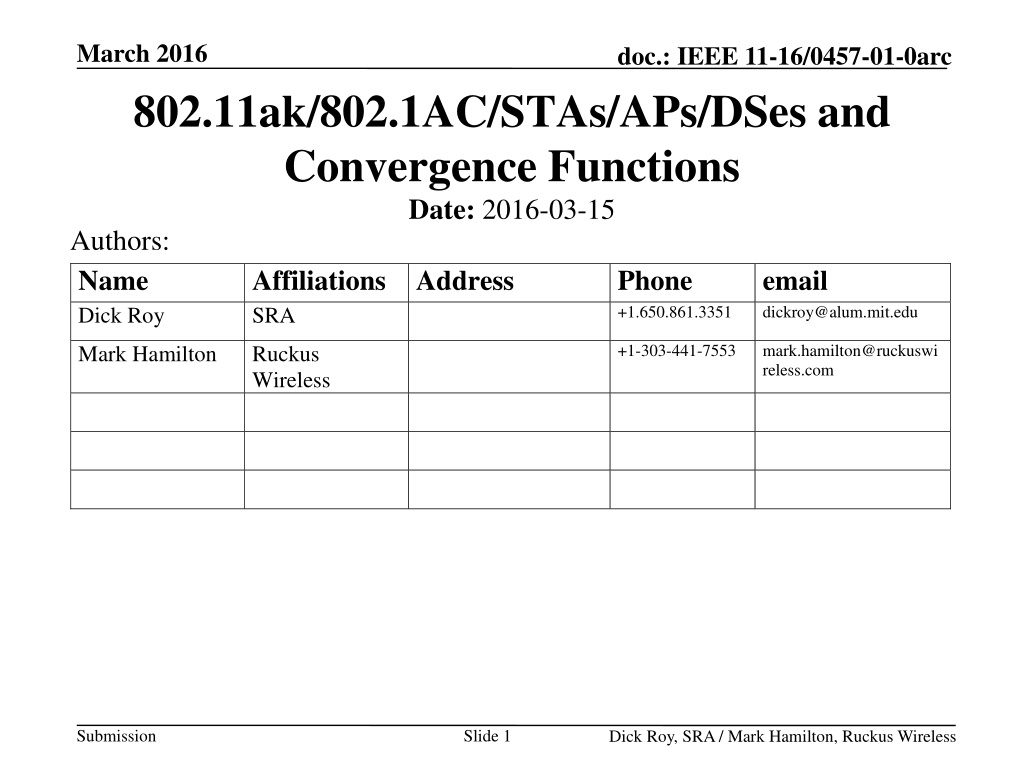
802.11ak and 802.1AC Convergence Functions in March 2016
Explore the convergence functions of 802.11ak and 802.1AC concepts presented in March 2016. This IEEE documentation delves into network architecture, layering models, and standard views of physical networks. Gain insights into portal integration and system configurations for enhanced connectivity.
Download Presentation

Please find below an Image/Link to download the presentation.
The content on the website is provided AS IS for your information and personal use only. It may not be sold, licensed, or shared on other websites without obtaining consent from the author. Download presentation by click this link. If you encounter any issues during the download, it is possible that the publisher has removed the file from their server.
E N D
Presentation Transcript
March 2016 802.11ak/802.1AC/STAs/APs/DSes and Convergence Functions Date: 2016-03-15 Authors: doc.: IEEE 11-16/0457-01-0arc Name Dick Roy Affiliations Address SRA Phone +1.650.861.3351 email dickroy@alum.mit.edu +1-303-441-7553 mark.hamilton@ruckuswi reless.com Mark Hamilton Ruckus Wireless Sli de 1 Submission Slide 1 Dick Roy, SRA / Mark Hamilton, Ruckus Wireless
March 2016 doc.: IEEE 11-16/0457-01-0arc Abstract Building upon a model being proposed for the IEEE 802.11 Portal Convergence Function, this presentation carries that concept into the 802.11ak concepts, and 802.1AC considerations for these extended concepts. Sli de 2 Submission Slide 2 Dick Roy, SRA / Mark Hamilton, Ruckus Wireless
March 2016 doc.: IEEE 11-16/0457-01-0arc Following are several slides from the 802.11 portal presentation (being considered in ARC, and 802.1AC) 11-14/497 Sli de 3 Submission Slide 3 Dick Roy, SRA / Mark Hamilton, Ruckus Wireless
March 2016 This is an example of a physical network doc.: IEEE 11-16/0457-01-0arc 802.3 802.3 AP 1 AP 2 Two physical boxes, commonly (but inaccurately) called APs, connected by an IEEE 802.3 link. Two clients of AP 1 shown, two wireless and one wired clients of AP 2 not shown. No VLANs. Sli de 4 Submission Slide 4 Dick Roy, SRA / Mark Hamilton, Ruckus Wireless
March 2016 Layering doc.: IEEE 11-16/0457-01-0arc In the ISO layering model, a DATA.request is presented by a higher layer to a lower layer, and a DATA.indication is presented by a lower layer to a higher layer. In all further diagrams in this deck, the higher layer is closer to the top of the slide, and the lower layer closer to the bottom. Sli de 5 Submission Slide 5 Dick Roy, SRA / Mark Hamilton, Ruckus Wireless
March 2016 A standard view of that same network in 802.11 today doc.: IEEE 11-16/0457-01-0arc AP AP portal MAC PHY MAC MAC Distribution System (DS) MAC PHY MAC PHY PHY PHY Non-AP STAs This is similar to IEEE 802.11-2012, Figure R-1, but drawn with request down indication up rigorously applied. The DS has three users, two APs and a portal, so is shown passing behind a MAC. AP STA 1 AP STA 2 unspecified 802.3 Sli de 6 Submission Slide 6 Dick Roy, SRA / Mark Hamilton, Ruckus Wireless
March 2016 One possible 802.1AC-to-portal architecture doc.: IEEE 11-16/0457-01-0arc AP portal 802.1Q bridge relay MAC MAC MAC PHY MAC PHY MAC PHY MAC PHY Distrib. System (DS) PHY PHY Non- AP station end station AP STA unspecified anything, e.g. 802.3 802.3 A connecting link is required, because the portal uses a SAP; it does not provide one. Therefore an 802.1AC convergence layer specific to 802.11 is not necessary. Sli de 7 Submission Slide 7 Dick Roy, SRA / Mark Hamilton, Ruckus Wireless
March 2016 But, there is an alternate approach. doc.: IEEE 11-16/0457-01-0arc AP portal 802.1Q bridge relay MAC MAC MAC PHY MAC PHY MAC PHY MAC PHY Distrib. System (DS) PHY PHY Non- AP station end station AP STA unspecified anything, e.g. 802.3 802.3 This interface is defined. It is the DS_SAP, illustrated in IEEE Std 802.11-2011 Figure R-1. Sli de 8 Submission Slide 8 Dick Roy, SRA / Mark Hamilton, Ruckus Wireless
March 2016 So, another representation could be One example (of many) of a portal doc.: IEEE 11-16/0457-01-0arc 802.1Q bridge relay .1AC MAC AP MAC MAC MAC PHY Distrib. System (DS) PHY PHY PHY Non- AP station end station 802.3 AP STA unspecified That is, the 802.1AC Clause 12.2.1 portal convergence function is not an interface to a portal; .1AC 12.2.1, plus a bridge relay function, is an example of a portal. .1AC 12.2.1 connects the ISS to the DS_SAP. Sli de 9 Submission Slide 9 Dick Roy, SRA / Mark Hamilton, Ruckus Wireless
March 2016 doc.: IEEE 11-16/0457-01-0arc New for 802.11ak consideration Sli de 10 Submission Slide 10 Dick Roy, SRA / Mark Hamilton, Ruckus Wireless
CHANGED March 2016 doc.: IEEE 11-16/0457-01-0arc Extending this to P802.11ak + P802.1Qbz 802.1Q bridge relay SAP SAP SAP SAP MA C MA C .1AC CF SAP[ ] .1AC CF SAP[ ] Conv. Funct AP AP MAC MAC MAC PHY PHY PHY PHY PHY Non-AP STAs That is, 802.1AC/802.11ak are defining a SAP and a convergence function that supports multiple, logical links as seen by the Bridge, to each of the 11ak-aware non-AP endpoints. 802.3 AP STA 1 AP STA 2 Sli de 11 Submission Slide 11 Dick Roy, SRA / Mark Hamilton, Ruckus Wireless
CHANGED March 2016 P802.11ak and non-11ak STNs on one AP. doc.: IEEE 11-16/0457-01-0arc AP w/Bridge and non-11ak (legacy) access Non-11ak STAs 11ak STAs Bridge .1AC .1AC AP MAC MAC MAC MAC MAC PHY DS PHY PHY PHY PHY Sli de 12 Submission Slide 12 Dick Roy, SRA / Mark Hamilton, Ruckus Wireless
CHANGED March 2016 P802.11ak and non-11ak STNs on two APs. doc.: IEEE 11-16/0457-01-0arc 11ak AP w/Bridge, uses DS for non-11ak access Non- 11ak STA(s ) 11ak AP w/Bridge and non-11ak (legacy) access Non- 11ak STA(s) 11ak STA(s ) 11ak STA(s ) Bridge Bridge isolated .1AC AP .1AC AP .1AC MAC MAC MAC MAC MAC PHY MAC PHY DS PHY PHY PHY PHY Sli de 13 Note that connectivity between this 11ak STN and the other stations depends on some connection between the Bridges not shown. Submission Slide 13 Dick Roy, SRA / Mark Hamilton, Ruckus Wireless
CHANGED March 2016 P802.11ak and non-11ak STNs on two APs. doc.: IEEE 11-16/0457-01-0arc AP Non- 11ak STA(s ) w/Bridge, uses DS for non- 11ak access Non- 11ak STA(s) 11ak STA(s ) 11ak STA(s ) AP w/Bridge and non-11ak (legacy) access Bridge Bridge .1AC AP .1AC AP .1AC .1AC MAC MAC MAC MAC MAC PHY MAC PHY DS DS PHY PHY PHY PHY Sli de 14 Now, all stations are fully connected, but the DS appears to be split. Submission Slide 14 Dick Roy, SRA / Mark Hamilton, Ruckus Wireless
CHANGED March 2016 P802.11ak and non-11ak STNs on two APs. doc.: IEEE 11-16/0457-01-0arc AP Non- 11ak STA(s ) w/Bridge, uses DS for non- 11ak access Non- 11ak STA(s) 11ak STA(s ) 11ak STA(s ) AP w/Bridge and non-11ak (legacy) access Bridge Bridge .1AC AP .1AC AP .1AC .1AC MAC MAC MAC MAC MAC PHY MAC PHY DS DS PHY PHY PHY PHY Sli de 15 In fact, the DS is not split; it is perfectly free to use the link provided by the bridges in order to accomplish its purposes. PROVIDED Submission Slide 15 Dick Roy, SRA / Mark Hamilton, Ruckus Wireless
CHANGED March 2016 P802.11ak and non-11ak STNs on two APs. doc.: IEEE 11-16/0457-01-0arc AP Non- 11ak STA(s ) w/Bridge, uses DS for non- 11ak access Non- 11ak STA(s) 11ak STA(s ) 11ak STA(s ) AP w/Bridge and non-11ak (legacy) access Bridge Bridge .1AC AP .1AC AP .1AC .1AC MAC MAC MAC MAC MAC PHY MAC PHY DS DS PHY PHY PHY PHY Sli de 16 The DS must not pass user data in parallel to the bridges data. (DS control data is fine. This is nothing new: hence the one portal rule, which we are purposely violating, here for optimal connectivity. Submission Slide 16 Dick Roy, SRA / Mark Hamilton, Ruckus Wireless
March 2016 Tasks for 802.1AC doc.: IEEE 11-16/0457-01-0arc Rewrite 802.1AC Draft 0.2 Clause 12.2.1 to provide a convergence function that maps multiple, logical ports visible to the bridge, to the vector-of-endpoints SAP provided by an 11ak AP. Sli de 17 Submission Slide 17 Dick Roy, SRA / Mark Hamilton, Ruckus Wireless
March 2016 Tasks for 802.11ak doc.: IEEE 11-16/0457-01-0arc Define the SAP presented by an 11ak AP to include the vector-of-endpoints parameter, which identifies links to each of the 11ak-aware non-AP STAs. Sli de 18 Submission Slide 18 Dick Roy, SRA / Mark Hamilton, Ruckus Wireless
March 2016 P802.11ak and non-11ak STNs on one AP. Non-11ak Non-AP STAs doc.: IEEE 11-16/0457-01-0arc AP w/Bridge and non-11ak (legacy) access 11ak Non- AP STAs Portal One-to-one mapping, 11ak non-AP STA to SAP Bridge SAP SAP Bridge .1AC SAP[ ] .1AC SAP SAP11ak DSAF MAC MAC MAC MAC SAP MAC PHY DS PHY PHY PHY PHY Sli de 19 Submission Slide 19 Dick Roy, SRA / Mark Hamilton, Ruckus Wireless
March 2016 P802.11ak and non-11ak STNs on one AP. Non-11ak Non-AP STAs doc.: IEEE 11-16/0457-01-0arc AP w/Bridge and non-11ak (legacy) access 11ak Non- AP STAs Portal One-to-one mapping, 11ak non-AP STA to SAP Bridge Bridge Bridge SAP SAP Portal .1AC MAC MAC SAP[ ] MAC MAC SAP11ak DSAF SAP SAP MAC PHY DS PHY PHY PHY PHY Sli de 20 With Portal still generic (not necessarily a bridge) And, MACs, Portal, Bridges height aligned to LLC layer Submission Slide 20 Dick Roy, SRA / Mark Hamilton, Ruckus Wireless
March 2016 P802.11ak and non-11ak STNs on one AP. Non-11ak Non-AP STAs doc.: IEEE 11-16/0457-01-0arc AP w/Bridge and non-11ak (legacy) access 11ak Non- AP STAs Portal One-to-one mapping, 11ak non-AP STA to SAP Bridge Bridge Bridge SAP SAP SAP Portal .1AC MAC MAC SAP[ ] MAC MAC SAP11ak DSAF SAP SAP MAC PHY DS PHY PHY PHY PHY Sli de 21 TBC: add a SAP to the AP bridge that allows MSDUs to get from the Bridge to the DS via the 11ak switching function. Submission Slide 21 Dick Roy, SRA / Mark Hamilton, Ruckus Wireless
March 2016 doc.: IEEE 11-16/0457-01-0arc There is an obvious problem! Q: How can such a simple idea (a layer 2 distribution service) require such complicated architectural diagrams, especially when the implementations are simple? A: It could be that the thinking about the architecture behind what constitutes an AP, a portal, and a DS needs some (slight) modification! Sli de 22 Submission Slide 22 Dick Roy, SRA / Mark Hamilton, Ruckus Wireless
March 2016 The (approximate) conclusions just in case you want to skip the details! doc.: IEEE 11-16/0457-01-0arc 1: APs that access [a/at least one] DS using a DSAF (not all APs do!) are (part of/wireless bridge port) L2 intermediate STAs (iSTAs, aka bridges!) with some special .11 functionalities including single-port bridge functionality . 2: A DS is a (bridged) LAN (L2 entity) from the viewpoint of the APs and portals that access it. How the DS is actually implemented really matters and is also out of .11 s scope! 3: A portal is a bridge (aka L2 relay service) between a DS (LAN) and a non-802.11 LAN. Sli de 23 4: [A/the] DSAF in an AP is (largely) conventional functionality inside a translational bridge . [cf. TSB] Submission Slide 23 Dick Roy, SRA / Mark Hamilton, Ruckus Wireless
March 2016 doc.: IEEE 11-16/0457-01-0arc The (approximate) conclusions (cont)! 5: An 11ak STA is (the part/wireless port of) a .1Q bridge with end station functionality and the STAs WLAN port . Frame translation is the responsibility of the other part of the .1Q bridge. 6: An 11ak AP is an AP with a/the DSAF constructed to: 1) interface with .1Q bridge functionality (cf. .1AC), and 2) to make the attached WLAN appear to the .1Q bridge as a segmented LAN [TSB] (instead of the shared LAN [TSB] it actually is!) (cf. .1AC, .11ak). Since the relay functionality is independent of [orthogonal to] AP functionality , it should be possible to do the same thing within an independent BSS (IBSS). Sli de 24 Submission Slide 24 Dick Roy, SRA / Mark Hamilton, Ruckus Wireless
March 2016 doc.: IEEE 11-16/0457-01-0arc Some Definitions (largely from The Switch Book, R. Seifert [TSB]) Protocol Data Units: segment: transport layer PDU packet: network layer PDU frame: data link layer PDU stream: physical layer PDU (also symbol stream) Sli de 25 Submission Slide 25 Dick Roy, SRA / Mark Hamilton, Ruckus Wireless
March 2016 doc.: IEEE 11-16/0457-01-0arc Some More Definitions Stations and Interconnections: station: any device that implements network services at the data link layer (or above) [TSB] end stations: aresources and/or sinks for all user data communicated across a network, and they support one or more user network applications [TSB] intermediate stations: serve as relay devices, forwarding messages generated by end stations across the network so they can reach their target end station destination(s) [TSB] Sli de 26 NB: any specific device may comprise both end station and intermediate station capabilities Submission Slide 26 Dick Roy, SRA / Mark Hamilton, Ruckus Wireless
March 2016 doc.: IEEE 11-16/0457-01-0arc Some More Definitions Data Links, LANs and access domains: data link: communication medium and set of stations used to exchange information using a common data link layer (layer 2 or L2) protocol (see also Local Area Network or LAN) Local Area Network (LAN): a network with relatively small geographic extent [TSB] [ed. an instantiation of an access domain; syn. shared LAN, often data link]. Two types are distinguished: wired LANs (LANs) and wireless LANs (or WLANs) access domain: a set of stations sharing a given LAN [ed. or data link] and arbitrating among themselves using the access control mechanism (cf. MAC protocol) is appropriate for that LAN. [TSB] [ed. the abstract concept instantiated by a LAN] Sli de 27 Submission Slide 27 Dick Roy, SRA / Mark Hamilton, Ruckus Wireless
March 2016 doc.: IEEE 11-16/0457-01-0arc Some More Definitions Intermediate stations are classified by the layer in the architecture at which they provide their relay function: bridge: an intermediate station that relays frames among various LAN data links (ed. or simply LANs).[TSB] bridged LAN: collection of LANs bridged together (also catenet) [TSB] router: an intermediate station that relays packets among networks (also internetwork router) [TSB] (for information only) internetwork: a collection of networks (using a common protocol) interconnected by routers (also internet) [TSB] (for information only) Sli de 28 IEEE 802.11 is concerned only with bridges and bridged LANs (L2 entities); entities above L2 including L3 routers are simply higher layer entities and are therefore out of .11 scope . Submission Slide 28 Dick Roy, SRA / Mark Hamilton, Ruckus Wireless
March 2016 doc.: IEEE 11-16/0457-01-0arc Some More Definitions Bridge ports and network interfaces:: bridge port: a network interface on a bridge.[TSB] network interface: a subsystem that provides the means for a computer or internetworking device to attach to a communications link [ed: LAN] [TSB] internetworking device: a device used to relay frames or packets among a set of networks (e.g., a bridge or router) [TSB] Sli de 29 Submission Slide 29 Dick Roy, SRA / Mark Hamilton, Ruckus Wireless
March 2016 doc.: IEEE 11-16/0457-01-0arc Baggy Pants Visted Anew Sli de 30 Submission Slide 30 Dick Roy, SRA / Mark Hamilton, Ruckus Wireless
March 2016 doc.: IEEE 11-16/0457-01-0arc Some More Definitions station (STA): A logical entity that is a singly addressable instance of a medium access control (MAC) and physical layer (PHY) interface to the wireless medium (WM). NOTE 21 For IEEE Std 802.11 purposes, a station is any MAC/PHY entity providing the IEEE Std 802.11 MAC services. This differs from the IEEE Std 802 (Overview and Architecture) definition of station, which includes bridges (or end stations ) that are endpoints of link layer data traffic. [REVmc] access point (AP): An entity that contains one station (STA) and provides access to the distribution services, via the wireless medium (WM) for associated STAs. An AP comprises a STA and a distribution system access function (DSAF). [REVmc] Sli de 31 Note: STAs have MAC-LLC SAPs (ML-SAPs) while APs currently do not so the definition of an AP as a STA w/extras might benefit from some minor revision. Submission Slide 31 Dick Roy, SRA / Mark Hamilton, Ruckus Wireless
March 2016 doc.: IEEE 11-16/0457-01-0arc IEEE 802.11 STAs and the LLC sublayer An IEEE 802.11 STA is a two-layer (OK one layer and a sublayer) entity that (to date) has a single wireless interface on the bottom and a single MAC-SAP on the top (a MAC-to-LLC sublayer-SAP, or ML-SAP for short) and NO other external interfaces. .11ak is adding functionality to STAs (effectively turning them into wireless bridge ports! Currently, from the IEEE 802 (and 802.11) perspective, the LLC sublayer ( above the MAC sublayer) consists of either: legacy (and disappearing) IEEE 802.2 LLC sublayer services (LPD and LLC-1 and LLC-2 services) in a sublayer, or no services (EPD the ONLY content of the LPDU header is the two- octet ethertype (aka the network layer (L3) destination address) (cf. .11ak and REvmc) Note: there are no addressable elements in the LLC sublayer. DSAP and SSAP addresses in LLC headers, or the ethertype in SNAP headers, refer to higher layer (L3) entities. Sli de 32 Submission Slide 32 Dick Roy, SRA / Mark Hamilton, Ruckus Wireless
March 2016 doc.: IEEE 11-16/0457-01-0arc An aside: Some New Developments Recent amendments (.11ad) that have multiple MACs on top of a single PHY can (probably) be treated as multiple STAs. If each MAC has a state machine and accesses the PHY with a multiplexing mechanism (time (TDM), frequency (OFDMA), code (CDMA), or spatial (SDMA)), the abstract definition of a STA as a MAC and PHY with an ML-SAP and a wireless interface still works. Sli de 33 Submission Slide 33 Dick Roy, SRA / Mark Hamilton, Ruckus Wireless
March 2016 doc.: IEEE 11-16/0457-01-0arc Some AP Observations An AP is (currently) a STA (not quite) with: NO ML-SAP (why not???) Required [ed: should be OPTIONAL] L2 functionality to access a distribution system (DS) which implies/requires access to another LAN through an (egress/ingress) interface other than the AP s wireless interface used to establish the BSS! Additional functionalities: beacons, point-coordination, authentication/association, etc.), and a LAN-local relay functionality(cf. a single-port bridge functionality ) that ultimately distinguish an AP from a STA, esp. when STAs (.11ak) have access to a DS! Sli de 34 Submission Slide 34 Dick Roy, SRA / Mark Hamilton, Ruckus Wireless
March 2016 doc.: IEEE 11-16/0457-01-0arc On .11 APs The definition of AP should be changed: provides should read can provide and access to a DS made optional because a BSS can exist whether or not there is access to a DS, AND because .11ak is changing things so STAs w/o BECF/SPBF (i.e. non-AP STAs) can become part of a .1Q bridged LAN which IS a DS. The real distinguishing features of APs are their BSS establishment and coordination functionality (BECF) and single-port bridge functionality (SPBF) . A thought: for consistency going forward, perhaps DSAF should be changed to DSCF (Distribution Service Convergence Function)? Sli de 35 Submission Slide 35 Dick Roy, SRA / Mark Hamilton, Ruckus Wireless
March 2016 doc.: IEEE 11-16/0457-01-0arc Some More Definitions Distribution systems and distribution services: distribution service: The [ed: A] service that, by using association information [ed: ?], delivers medium access control (MAC) service tuples within [ed: using] the distribution system (DS). [REVmc] distribution system (DS): A system used to interconnect a set of basic service sets (BSSs) and integrated [ed: ?] local area networks (LANs) to create an extended service set (ESS). [REVmc] Sli de 36 Submission Slide 36 Dick Roy, SRA / Mark Hamilton, Ruckus Wireless
March 2016 doc.: IEEE 11-16/0457-01-0arc Some More DS Fundamentals And a DS is supposed to [IEEE Std 802.11 is required to] appear to higher layers [logical link control (LLC) sublayer] as a wired IEEE 802 LAN. [REVmc] enable[s] mobile device support by providing the logical services necessary to handle address to destination mapping and seamless integration of multiple BSSs . [REVmc] make an [The key concept is that the] ESS appear[s] the same to an LLC [ed: sub] layer [ed: entity] as an IBSS. STAs within an ESS can communicate and mobile STAs might move from one BSS to another (within the same ESS) transparently to LLC [ed: sublayer entities but there aren t any?]. [REVmc] Sli de 37 Submission Slide 37 Dick Roy, SRA / Mark Hamilton, Ruckus Wireless
March 2016 doc.: IEEE 11-16/0457-01-0arc Some More Definitions Integration service and portals:: portal: The logical point at which the integration service is provided. NOTE 15 For the purposes of this Standard, there is at most one portal in a given ESS s infrastructure. In an implementation, a single logical portal function may be provided by multiple devices that provide integration services for the ESS. How such multiple devices coordinate to appear as a single logical portal is implementation dependent. [REVmc] integration service: The service that enables delivery of medium access control (MAC) service data units (MSDUs) between the distribution system (DS) and a local area network (LAN) (via a portal). [REVmc] Sli de 38 Submission Slide 38 Dick Roy, SRA / Mark Hamilton, Ruckus Wireless
March 2016 doc.: IEEE 11-16/0457-01-0arc An aside: What is an infrastructure really? infrastructure: An infrastructure comprises a distribution system (DS), one or more APs, zero or one portal, and zero or more mesh gates. It is also the logical location of distribution and integration service functions of an extended service set (ESS). c[REVmc] extended service set (ESS): A set of one or more interconnected basic service sets (BSSs) that appears as a single BSS to the logical link control (LLC) layer at any station (STA) associated with one of those BSSs. Sli de 39 ????????????? Submission Slide 39 Dick Roy, SRA / Mark Hamilton, Ruckus Wireless
March 2016 doc.: IEEE 11-16/0457-01-0arc Some More DS Observations The IEEE 802.11 DS was purposefully left unspecified so vendors could implement AP-AP & AP- node-on-LAN connectivity however they chose. This does NOT imply that ANY means for connecting APs and other nodes qualifies as an IEEE 802.11 DS. It would be, and still is, out-of-scope for IEEE 802.11 to specify ANYTHING above the MAC sublayer, so to specify any DS functionality above the MAC sublayer (e.g. routing) is out-of- scope. Sli de 40 CONCLUSION: While the structure of a DS is arbitrary , access to it by an AP is not. Between APs, and between an AP and a portal, the distribution service must appear as an L2 relay service, i.e. a bridge relay service! Submission Slide 40 Dick Roy, SRA / Mark Hamilton, Ruckus Wireless
March 2016 doc.: IEEE 11-16/0457-01-0arc What is a DS really? CONCLUSION: An IEEE 802.11 DS is system for implementing a distribution service comprising relay functionality with layer 2 access that uses layer 2 (MAC) addresses to exchange frames between peer L2 (MAC) entities in STAs associated with a (set of) BSSes as well as other nodes/stations in other local area networks (LANs) The service offered by an IEEE 802.1Q bridge is an example of such a service! (NF) Sli de 41 Submission Slide 41 Dick Roy, SRA / Mark Hamilton, Ruckus Wireless
March 2016 doc.: IEEE 11-16/0457-01-0arc The (approximate) conclusions! 1: APs that access [a/at least one] DS using a DSAF (not all APs do!) are (part of/wireless bridge port) L2 intermediate STAs (iSTAs, aka bridges!) with some special .11 functionalities including single-port bridge functionality . 2: A DS is a (bridged) LAN (L2 entity) from the viewpoint of the APs and portals that access it. How the DS is actually implemented really matters and is also out of .11 s scope! 3: A portal is a bridge (aka L2 relay service) between a DS (LAN) and a non-802.11 LAN. Sli de 42 4: [A/the] DSAF in an AP is (largely) conventional functionality inside a translational bridge . [cf. TSB] Submission Slide 42 Dick Roy, SRA / Mark Hamilton, Ruckus Wireless
March 2016 doc.: IEEE 11-16/0457-01-0arc The (approximate) conclusions (cont)! 5: An 11ak STA is (the part/wireless port of) a .1Q bridge with end station functionality and the STAs WLAN port . Frame translation is the responsibility of the other part of the .1Q bridge. 6: An 11ak AP is an AP with a/the DSAF constructed to: 1) interface with .1Q bridge functionality (cf. .1AC), and 2) to make the attached WLAN appear to the .1Q bridge as a segmented LAN [TSB] (instead of the shared LAN [TSB] it actually is!) (cf. .1AC, .11ak). Since the relay functionality is independent of [orthogonal to] AP functionality , it should be possible to do the same thing within an independent BSS (IBSS). Sli de 43 Submission Slide 43 Dick Roy, SRA / Mark Hamilton, Ruckus Wireless
March 2016 doc.: IEEE 11-16/0457-01-0arc The Illustrative Impact An 11ak STA is the wireless part/bridge port of an L2 intermediate and end station (eiSTA) which is an object needed (in drawings too!) to connect a .11 WLAN to another LAN. An 11ak AP is the wireless part/bridge port of an L2 intermediate (iSTA/(e)iSTA) which is another object needed (in drawings too!) to connect a .11 WLAN to a DS (via another LAN). A DS access/convergence function communicates with the distribution service using a SAP between the DS convergence function in the MAC sublayer and the distribution service (the MD-SAP ) and it s sideways ! Sli de 44 Submission Slide 44 Dick Roy, SRA / Mark Hamilton, Ruckus Wireless
March 2016 doc.: IEEE 11-16/0457-01-0arc Legend MAC STA with no AP functionality and no access to a DS PHY MAC STA with no AP functionality and access to one or more DSes PHY MAC STA with AP functionality and access to one or more DSes PHY Sli de 45 DSCF Submission Slide 45 Dick Roy, SRA / Mark Hamilton, Ruckus Wireless
March 2016 doc.: IEEE 11-16/0457-01-0arc APs, STAs, a DS and an ESS DSCF DSCF MAC Distribution System (DS) MAC MAC MAC MAC PHY PHY PHY PHY PHY unspecified As this depicts an ESS, the BSSIDs for both BSSes is the same! Independent BSSes with no AP could be used as long as the DSCF in the STAs had the appropriate functionality. Sli de 46 Submission Slide 46 Dick Roy, SRA / Mark Hamilton, Ruckus Wireless
March 2016 doc.: IEEE 11-16/0457-01-0arc REFERENCES [REVmc] Draft P802.11REVmc_D5.2 [O&A] IEEE Std 802-2014 [.1Q] IEEE Std 802.1Q [.1AC] IEEE Std 802.1AC [TSB] The Switch Book, R. Seifert, 2000 Sli de 47 Submission Slide 47 Dick Roy, SRA / Mark Hamilton, Ruckus Wireless

